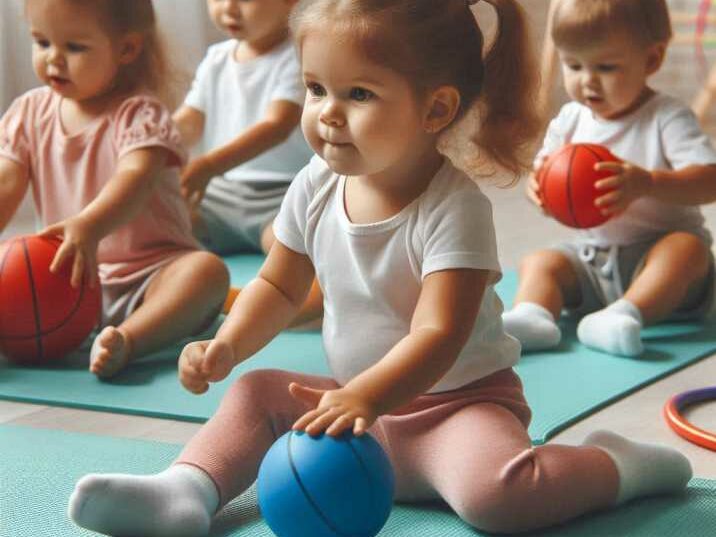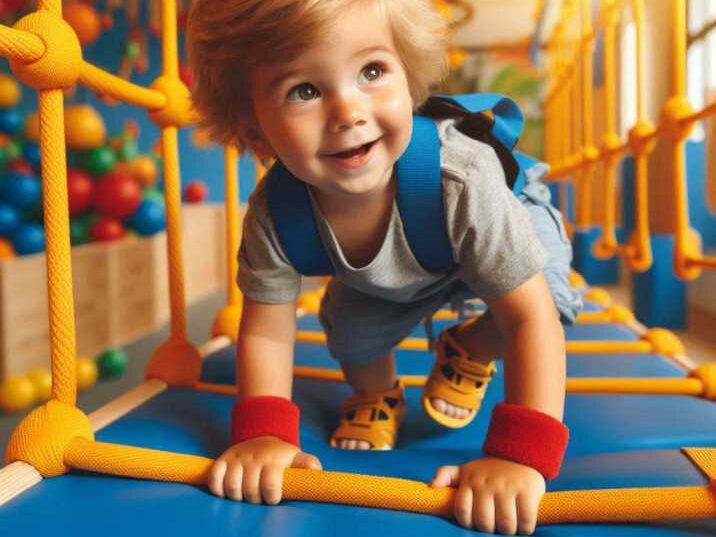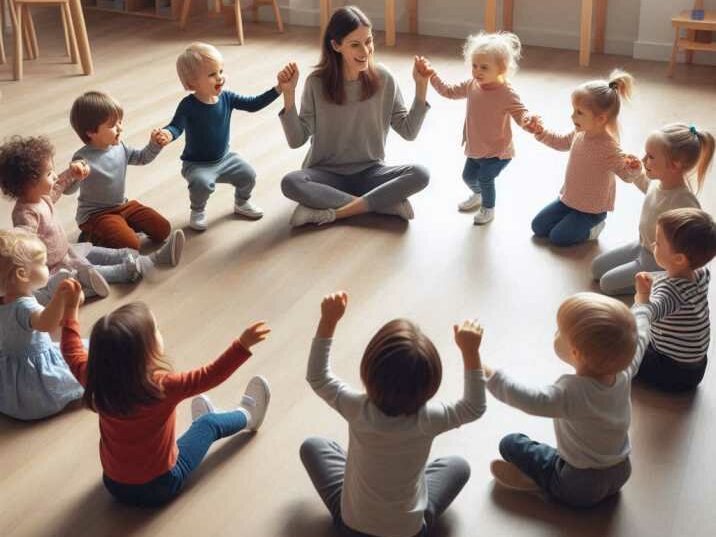Introduction
Table of Contents
As parents or caregivers, you might often wonder what activities best suit your energetic two-year-old. At this age, toddlers are full of curiosity and boundless energy, constantly exploring the world around them. Introducing sport activities can be a fantastic way to channel that energy constructively while fostering physical, cognitive, and social development. In this blog post, we will delve into a variety of fun and engaging sport activities tailored for two-year-olds, ensuring a blend of entertainment and developmental benefits.

Why Are Sport Activities Important for 2-Year-Olds?
Physical Development
At two years old, children are rapidly developing their gross motor skills. This includes activities that help them gain balance, coordination, and strength. Engaging in physical activities encourages muscle growth and bone development and improves overall health and fitness.
Cognitive Development
Sport activities can significantly enhance cognitive abilities. As toddlers participate in various games and exercises, they learn to follow instructions, solve simple problems, and make decisions, all of which are crucial for cognitive growth.
Social and Emotional Development
Participating in group activities introduces two-year-olds to social interactions. They learn to share, take turns, and communicate with their peers, fostering emotional intelligence and social skills.
Choosing the Right Sport Activities for 2-Year-Olds
Considerations for Parents
Before diving into specific activities, it’s essential to consider the following:
- Safety: Ensure the activity is safe and age-appropriate. Use soft and child-friendly equipment.
- Interest: Choose activities that align with your child’s interests and personality.
- Supervision: Always supervise toddlers during activities to prevent accidents.
- Encouragement: Provide positive reinforcement to boost your child’s confidence and motivation.
Top Sport Activities for 2-Year-Olds
Here are some of the best sport activities that are both fun and beneficial for two-year-olds:
1. Creating a Safe and Fun Environment: Obstacle Course
Setting Up the Obstacle Course
Creating an obstacle course for your toddler is a wonderful way to engage them physically while also challenging their problem-solving skills. Here’s how you can set up a simple and safe course at home:
- Pillows and Cushions: Use pillows and cushions to create safe obstacles that your toddler can climb over or crawl under. Arrange them in a way that forms a zigzag path or a mini-maze.
- Boxes: Utilize empty cardboard boxes to create tunnels or low barriers. Ensure the edges are smooth and the boxes are stable.
- Tunnels: Purchase or make a play tunnel using fabric and hoops. This element adds excitement as your toddler crawls through.
- Toys and Cones: Scatter toys or place cones along the path that your child must navigate around.
Benefits and Skills Developed
- Balance and Coordination: Navigating through the course requires your toddler to maintain balance and develop coordination as they climb, crawl, and maneuver through obstacles.
- Problem-Solving: As they figure out how to get from one part of the course to another, toddlers enhance their problem-solving skills, learning to plan their movements and overcome challenges.
- Confidence: Successfully completing the obstacle course boosts your child’s confidence. They gain a sense of achievement, which encourages them to try new activities.
Parental Involvement
- Guidance and Supervision: Offer guidance if needed, but allow your child to explore the course independently. This encourages self-reliance and decision-making.
- Positive Reinforcement: Celebrate your toddler’s efforts and successes to build their confidence and motivation.

2. Ball Games: Kick, Throw, and Catch
Introducing Ball Games
Ball games are a classic and versatile way to engage toddlers in physical activity. Here’s how you can introduce these games effectively:
- Kick: Use a soft, lightweight ball for kicking activities. Encourage your toddler to kick the ball to you or into a small goal. This helps develop leg strength and coordination.
- Throw: Teach your toddler to throw a ball using both hands. Start with short distances and gradually increase the distance as their skills improve.
- Catch: Begin with rolling the ball back and forth, then progress to catching. Use a large, soft ball that’s easy for little hands to grasp.
Benefits and Skills Developed
- Gross Motor Skills: Kicking, throwing, and catching a ball require using large muscle groups, which aids in developing gross motor skills.
- Hand-Eye Coordination: As your child tracks the ball’s movement and responds accordingly, they improve their hand-eye coordination.
- Teamwork (if playing with others): Playing ball games with others introduces basic teamwork concepts, such as taking turns and cooperating with peers.
Creating a Fun Environment
- Variety: Change up the games to keep your toddler interested. Introduce new challenges or variations as their skills improve.
- Interactive Play: Play along with your child or invite siblings and friends to join in, making it a social and interactive experience.
3. Dancing: Expressing Through Movement
Hosting a Dance Party
Dancing is a fantastic way to engage toddlers physically and creatively. Here’s how you can make dancing a regular part of your routine:
- Music Selection: Choose upbeat and age-appropriate music that encourages movement. Songs with simple rhythms and fun lyrics are ideal for toddlers.
- Dance Moves: Introduce basic dance moves that your toddler can easily imitate, such as clapping, jumping, spinning, and stomping.
- Free Movement: Allow your child to move freely and express themselves through their unique dance style. Encourage creativity and imagination.
Benefits and Skills Developed
- Rhythm and Coordination: Dancing helps toddlers develop a sense of rhythm and coordination as they learn to move in time with the music.
- Self-Expression: Through dance, toddlers express their emotions and ideas, fostering creativity and emotional intelligence.
- Physical Fitness: Dancing is a full-body workout that improves cardiovascular health, strengthens muscles, and enhances flexibility.
Making Dancing Enjoyable
- Join the Fun: Dance with your toddler to model enthusiasm and create a bonding experience.
- Themed Dance Parties: Host themed dance parties, such as a “jungle dance” where you mimic animal movements, to keep the activity fresh and exciting.
- Praise and Encourage: Applaud your child’s dance moves and encourage them to experiment with new movements, boosting their confidence and joy in dancing.

4. Swimming: Water Fun for Little Ones
Introducing Toddlers to Swimming
Swimming is a fantastic activity for toddlers, offering a unique environment for physical development and fun. Here’s how to introduce your toddler to swimming safely and effectively:
- Safe Environment: Choose a shallow pool or a designated toddler swimming area where your child can comfortably stand and move around. Ensure the water temperature is appropriate for young children.
- Flotation Devices: Equip your toddler with flotation devices, such as swim vests or arm floaties, to provide extra support and safety in the water.
- Parent Participation: Enter the water with your child, offering support and guidance. This helps build their confidence and ensures they feel secure.
Benefits and Skills Developed
- Water Safety Awareness: Swimming introduces toddlers to essential water safety concepts, such as understanding boundaries and learning to respect the water.
- Strength and Endurance: Moving through the water requires more effort than on land, promoting muscle strength and cardiovascular endurance.
- Confidence in Water: As toddlers become more comfortable in the water, their confidence grows, encouraging them to explore and enjoy the activity.
Tips for a Positive Swimming Experience
- Start Slowly: Begin with short sessions and gradually increase the time as your child becomes more comfortable.
- Make it Fun: Incorporate water toys and games to make swimming enjoyable. Sing songs, splash around, and encourage your toddler to kick and move.
- Supervision is Key: Always maintain close supervision and remain within arm’s reach of your child while they are in or near the water.
5. Running and Chasing Games:
Engaging in Running and Chasing Games
Running and chasing games, such as tag, are excellent ways to channel your toddler’s energy and improve their physical abilities. Here’s how to make these games both fun and beneficial:
- Choose Open Spaces: Use a safe, open area like a backyard or park where your toddler can run freely without obstacles.
- Simple Rules: Keep the rules straightforward and easy to understand. For instance, in tag, one person is “it,” and they must gently touch another to pass the “it” status.
- Incorporate Variations: Introduce variations like freeze tag, where tagged players must freeze until another player unfreezes them, to keep the games exciting.
Benefits and Skills Developed
- Speed and Agility: Running and chasing games help toddlers develop speed, agility, and quick reflexes as they navigate the playing area.
- Social Interaction: Playing with others encourages social interaction, cooperation, and communication, essential for developing social skills.
- Listening Skills: Understanding and following game rules enhances listening skills and the ability to process instructions.
Enhancing the Experience
- Join In: Participate in the games with your toddler to model enthusiasm and reinforce the fun.
- Praise Effort: Encourage your child by praising their effort and participation rather than focusing on winning or losing.
6. Yoga for Toddlers: Mindful Movement
Introducing Toddlers to Yoga
Yoga offers toddlers a gentle way to develop physical and mental skills while promoting relaxation and mindfulness. Here’s how to introduce yoga to your child:
- Basic Poses: Start with simple poses that toddlers can easily imitate, such as the tree pose (standing on one leg), the downward dog (bending forward with hands on the ground), and the butterfly (sitting with feet together and knees apart).
- Animal Themes: Use animal-themed poses to make yoga fun and engaging, like pretending to be a lion (roaring while in a seated position) or a cat (arching the back).
- Short Sessions: Keep yoga sessions brief, focusing on a few poses to maintain your toddler’s attention and interest.
Benefits and Skills Developed
- Flexibility and Balance: Yoga enhances flexibility and balance as toddlers learn to hold poses and shift their weight.
- Mindfulness and Relaxation: Practicing yoga introduces mindfulness and relaxation techniques, helping toddlers manage emotions and calm their minds.
- Focus and Concentration: Holding poses and following instructions improve focus and concentration.
Tips for a Successful Yoga Session
- Create a Calm Environment: Use a quiet space with soft lighting and soothing music to set the mood for yoga practice.
- Lead by Example: Demonstrate poses and encourage your toddler to mimic your movements, fostering a shared experience.
- Encourage Creativity: Allow your toddler to explore new poses and movements, promoting creativity and self-expression.
7. Scooting and Biking: Wheels on the Move
Introducing Scooters and Balance Bikes
Scooting and biking are excellent activities for developing balance and coordination. Here’s how to introduce your toddler to these wheeled adventures:
- Balance Bikes: Start with a balance bike, which has no pedals, to help your toddler learn balance and steering. They can propel themselves forward using their feet.
- Scooters: Choose a three-wheeled scooter with a stable base and easy-to-grip handlebars, allowing your toddler to practice balance while scooting.
- Safety Gear: Always equip your child with a helmet and protective gear to ensure safety during these activities.
Benefits and Skills Developed
- Balance and Coordination: Riding a balance bike or scooter enhances balance and coordination as toddlers learn to control their movements.
- Independence: These activities promote independence as toddlers gain the confidence to move and explore on their own.
- Safety Awareness: Riding requires awareness of surroundings and safety measures, instilling a sense of responsibility in young children.
Enhancing the Riding Experience
- Practice in Safe Areas: Use smooth, flat surfaces in safe areas such as sidewalks or driveways for practice.
- Encourage Exploration: Allow your toddler to explore their surroundings at their own pace, fostering curiosity and adventure.
- Celebrate Milestones: Acknowledge progress and celebrate milestones, such as riding without assistance or learning to steer.
8. Simple Gymnastics: Tumbling and Rolling
Introducing Toddlers to Gymnastics
Simple gymnastics activities, such as tumbling and rolling, provide a foundation for physical development and body awareness. Here’s how to get started with toddler gymnastics:
- Home Setup: Create a safe space at home with soft mats or padded areas for tumbling and rolling activities.
- Basic Moves: Introduce simple moves like forward rolls, log rolls, and gentle cartwheels. Encourage your toddler to explore movement in a safe and controlled manner.
- Beginner Classes: Consider enrolling your toddler in a beginner gymnastics class where they can learn foundational skills under the guidance of an instructor.
Benefits and Skills Developed
- Flexibility and Strength: Gymnastics activities improve flexibility and strength as toddlers learn to stretch and support their bodies in various positions.
- Body Awareness: Tumbling and rolling enhance body awareness, helping toddlers understand how their bodies move and interact with space.
- Confidence: Mastering new skills in gymnastics builds confidence and a sense of achievement.
Tips for a Positive Gymnastics Experience
- Provide Support: Offer physical support and guidance as your toddler learns new movements, ensuring their safety and comfort.
- Celebrate Achievements: Celebrate your child’s accomplishments, whether it’s a successful roll or an improved stretch, to boost their confidence.
- Encourage Exploration: Allow your toddler to explore different movements and poses, promoting creativity and self-discovery.
Tips for Encouraging Participation
- Be a Role Model: Participate in activities with your child to motivate them.
- Create a Routine: Set a regular schedule for activities to build consistency.
- Celebrate Achievements: Praise your child’s efforts and progress, no matter how small.
- Be Patient: Allow your child to explore activities at their own pace without pressure.
Safety Guidelines for Sport Activities
- Use Appropriate Gear: Ensure your child wears suitable clothing and protective gear for each activity.
- Supervise Closely: Always watch your toddler during activities to prevent accidents.
- Choose Safe Environments: Select safe and clean play areas free from hazards.
- Stay Hydrated: Encourage regular water breaks to keep your child hydrated.
Conclusion
Introducing sport activities to your two-year-old is a wonderful way to promote their physical, cognitive, and social development. By choosing age-appropriate and engaging activities, you can create a positive and enriching experience for your child. Remember, the goal is to have fun while fostering growth, so be patient and supportive as your toddler explores the world of play.
FAQs
1. What are the best indoor sport activities for 2-year-olds?
Indoor sport activities such as obstacle courses, dancing, and yoga are excellent for 2-year-olds as they promote physical development and can be done in a safe environment.
2. How do I know if an activity is age-appropriate for my toddler?
Look for sport activities designed for toddlers that focus on simple movements and use child-friendly equipment. Ensure the activity is safe and aligns with your child’s interests and abilities.
3. How much physical activity does a 2-year-old need daily?
Toddlers should have at least 60 minutes of structured physical sport activity and several hours of unstructured play daily to promote healthy development.
4. What should I do if my child loses interest in an activity?
Try introducing a variety of activities to keep things exciting. If your child loses interest, gently encourage them but don’t force participation. Sometimes taking a break and revisiting the activity later helps.
5. Are there any sport activities that promote both physical and cognitive development?
Yes, sport activities like ball games, obstacle courses, and simple gymnastics promote both physical and cognitive development by enhancing motor skills and problem-solving abilities.


